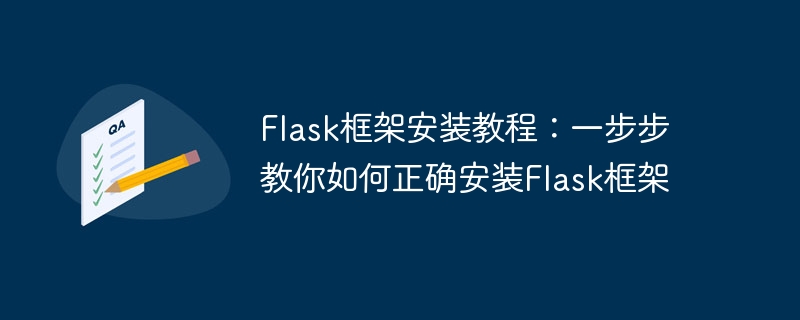

Flask framework installation tutorial: teach you step by step how to correctly install the Flask framework, specific code examples are required
Introduction:
Flask is a simple and flexible Python web development framework. It's easy to learn, easy to use, and packed with powerful features. This article will lead you step by step to correctly install the Flask framework and provide detailed code examples for reference.
Step One: Install Python
Before installing the Flask framework, you first need to ensure that Python is installed on your computer. You can download the latest version of Python from the official Python website (https://www.python.org/downloads/). Select the corresponding installation program according to the operating system you are using, and follow the prompts to install Python.
Step 2: Use pip to install Flask
After installing Python, we need to use pip (Python's package management tool) to install the Flask framework. Open a command line terminal (Windows users can use Command Prompt or PowerShell, Mac and Linux users can use Terminal), enter the following command to install Flask:
pip install flask
This will automatically download and install the Flask framework and its dependencies all libraries. After the installation is complete, you can enter the following command to check whether Flask is installed successfully:
flask --version
If you see output similar to "Flask 1.1.2", it means that Flask has been installed successfully.
Step 3: Create a simple Flask application
Next, let us create a simple Flask application to verify whether the installation is successful. Open any text editor, create a file calledapp.py, and copy and paste the following code into the file:
from flask import Flask app = Flask(__name__) @app.route('/') def hello_world(): return 'Hello, Flask!' if __name__ == '__main__': app.run()
After saving the file, switch to the file in the command line directory and enter the following command to launch the Flask app:
python app.py
If everything is fine, you will see an output similar to the following:
* Running on http://127.0.0.1:5000/ (Press CTRL+C to quit)
Now, in your web browser Enterhttp://127.0.0.1:5000/. If you see "Hello, Flask!" displayed on the page, it means that your Flask application has run successfully.
Summary:
In this article, we introduce step by step how to correctly install the Flask framework and provide a simple code example as verification. Hopefully, through this tutorial, you will be able to successfully install Flask and start using it for web development. Flask has a rich extension library and flexible architecture, which can meet various web development needs. I wish you more success in developing with Flask!
The above is the detailed content of Guide to installing the Flask framework: Detailed steps to help you install Flask correctly. For more information, please follow other related articles on the PHP Chinese website!